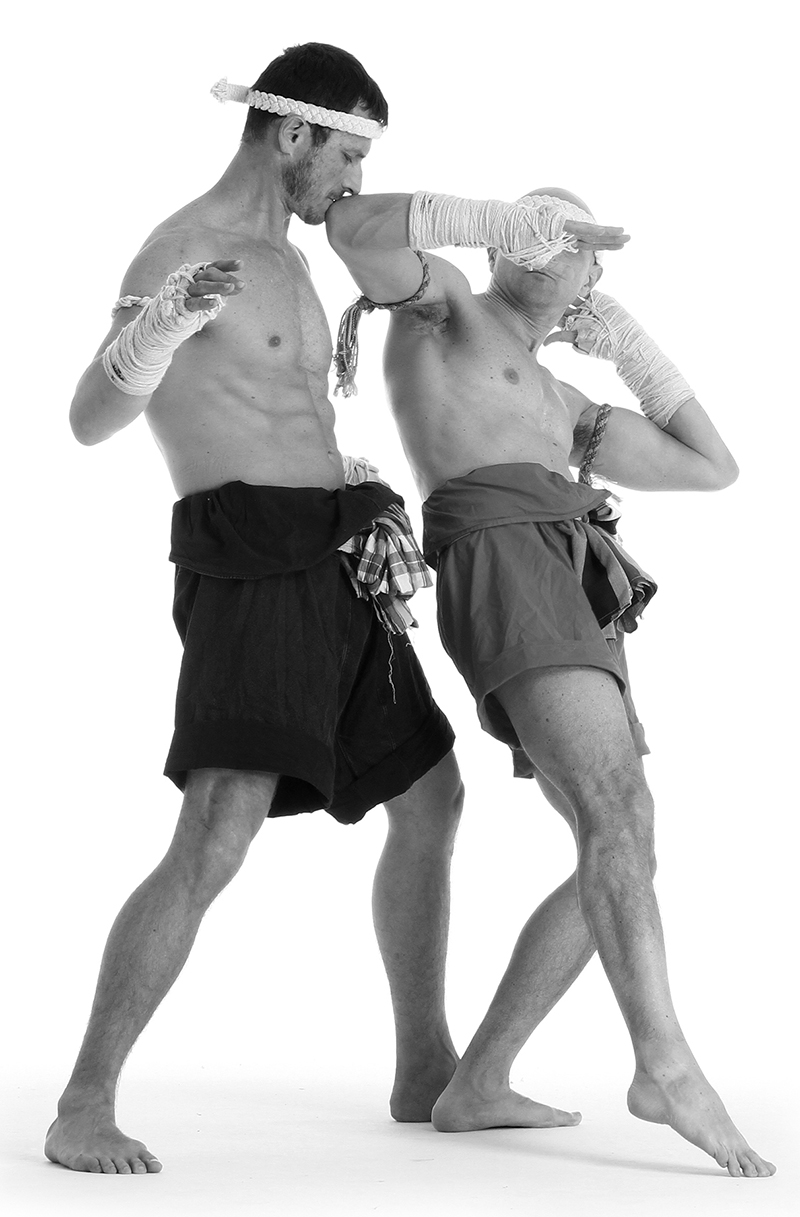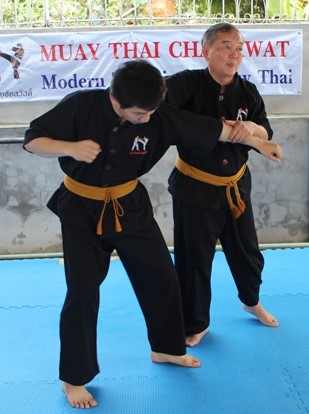
The elusive Art of counter fighting: Kon Muay Kae style (part 2)
Kon, กล trick; scheme; stratagem.
Kae,แก้ to correct; to counteract; to solve a problem.
As we have seen (The elusive Art of counter fighting part 1), the core of Kon Kae style of fighting is learning to cope with any kind of attack the opponent may use and countering accordingly. This ancestral style is very complex and includes some universal principles of hand to hand combat. Siamese traditions related to barehanded fighting are many and varied: only through an in-depth analysis of the heritage of the most prominent masters of this Art it is possible to dig-out the true essence of Muay.
One of the living thai masters who structured his vast knowledge in a clear and logical way, understandable for foreign students, too, is Master Chaisawat Tienviboon. He analysed the heritage of past masters of Muay with an open spirit and a logical mind. In fact, besides being one of the foremost Khru Muay with more than 50 years of experience in Siamese martial arts, he was also associated professor, Faculty of Engineering at King Mongkut University of Technology. I was very lucky to receive from Master Chaisawat many suggestions and detailed instructions about many aspects of Muay Thai teaching. He also instructed me about the levels of fighting. This concept is closely related to analysis of counter fighting that I am presenting through this series of articles.
Master Chaisawat identifies 4 levels of fighting in Muay.
The first level corresponds to a street brawl during which the opponents exchange blows without caring about defense. Uncontrolled rage is the dominant feeling that compels the street fighters to charge blindly trying to overpower each other. No blocking or slipping is used and both contestants are focused exclusively on attacking as hard and as fast as possible. Usually, the first one who connects with a telling blow is going to win the fight. This level has clearly nothing to do with martial arts and therefore thai masters compare it to “splashing the opponent with mud”.
Level two is much more sophisticated and corresponds to the basic teaching system used in most Muay Thai schools. When a fighter has reached level 2 it means that he can apply the basic defensive strategies to repel his opponent’s offensive and is in condition to retaliate accordingly. In the accompanying video an example of a parry followed by an elbow strike to the ribcage.
The simplest defensive strategies that are used at this level are: Pong, Pad, Pid, Poed. Let’s see the meaning of this 4 Thai words.
Pong: refers to stopping blows with the palm of the hand. Otherwise the attacks may be stopped just by raising one’s guard.
Pad: parrying the blows with the hand or the forearm. The attack can be diverted towards the interior or exterior line, downwards or upwards.
Pid: closing the gates. Covering the weak spots or blocking the attacks using the hard bony parts of the defender’s body. You can stop blows with the forehead (hua), with the shoulder (lai), with the forearm (kaen), with the elbow (sok), with the shin (kaeng), with the knee (kao).
Poed: opening the opponent’s guard. Deflecting the attack while penetrating the adversary’s guard can be done with one or two arms, with one or two hands.
Once the basic defensive action has been successfully applied, the defender should immediately counterattack with one or more strikes. In order to do that, his maneuvers must be very sharp and well timed. Because of that, this level of fighting is usually called “sharp fighting”. One of the drawbacks of this way of fighting is that the defender’s body must be strong enough to withstand the impact of blows that he is doomed to suffer before he can retaliate with his own counter strikes. In Muay Thai, where boxers are paired according to strict weight classes, this may not be a big issue. On the contrary, in “martial fighting” the weight difference plays a big role, in favour of the heavier contender. Therefore, in ancient Muay, this level of fighting was considered pretty basic and a Nak Muay (thai boxer) who had reached the status of “sharp fighter” was still far from being at the top of his Art.
Level 3 is a difficult one to master. Not many fighters will ever possess the skills inherent in this level. The Nak Muay who can dodge, slip or sidestep the opponent’s attacks and retaliate with lighting fast counters, is going to be the winner most of the times. If your enemy’s (body) weapons cannot touch you, they cannot hurt you. The problem here is that the defensive system used at this level is very advanced and not all fighters are able to master it unless they possess some natural attributes. The first and most important attribute for a level-3 fighter is possessing good reflexes. Without the ability to detect the opponent’s attack before it is completed, dodging his strike, making him barely miss the target, a boxer will never reach this level and will have to keep on structuring his style around a more basic approach (i.e., level 2). On the other hand, if a fighter is able to master these advanced tactics and manages to apply them in combat, every kind of opponent will have a very hard time facing him. No matter how big the adversary, a level-3 fighter will be always out of reach of the attacker’s strikes and will not suffer any hard impact. Too far or too close, he will spin a spider web around the attacker, hitting him from unexpected angles, aiming at the weakest spots of his anatomy. For this reason this level of fighting is called “wrap around”. In the video an example of inside slip followed by a short hook to the throat.
Level 4 is even more complex and harder to master. Before being instructed in the subtleties of this level, a Nak Muay should be well versed in level 2 and 3. In level 4, the defender is actually the one who takes the initiative: closing the distance and attacking first can easily be mistaken with a “simple” direct attack. However, the fighter who has reached this pinnacle of Muay, is actually attacking the opponent’s attack. In simple words, as soon as he detects the opponent’s “intent” to strike (or to step forward in order to strike), the defender anticipate his attack and, like a cobra, strikes first. The secret of this very high skill is to move when the opponent is already “committed to attack”. If the defender just switch to attacker’s mode and become the aggressor, he will lose all the strategic advantages of counter fighting. Straightforward attacks have nothing to do with Kon Kae style and with level 4 fighting. The mental aspect is preponderant at this stage: facing off against a strong opponent keeping a clear mind (so called empty mind) is no easy task. The body must be kept relaxed, breathing must be controlled and no trace of hesitation must be in the defender’s heart. When someone reaches this level of fighting his defense and attack will be as one and very few opponents will be able to resist him because he has attained the coveted skill of “sudden attack”. In the video a preventive diagonal upward straight punch to the chin against an attempted left jab.


